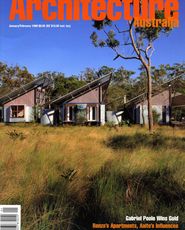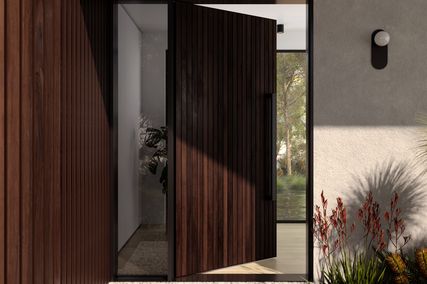|
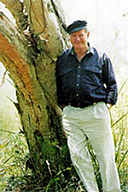
Gabriel Poole. Image: Slipstream.
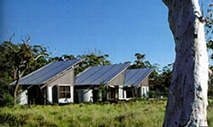
Poole house at Lake Weyba, 1997, looking north-west. Image: Reiner Blunck.
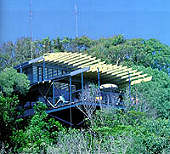
The Simon and Jenny Poole house, 1985. Image: Marek Coowatch.
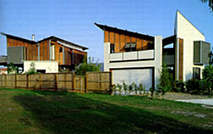
The Bailey residence at the Twin Waters estate, Noosa, looking east from the street. Image: Marek Coowatch.
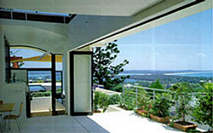
Top floor of Alkira Apartments, Noosa Heads, 1996. Image: Marek Coowatch.
|
RAIA Gold Medal Citation
In many ways, the achievements of Gabriel Poole can be taken to represent the ideals and aspirations of the majority of sole practitioners who are the backbone of the profession. He has consistently maintained an exploratory and innovative stance to the making of architecture and his career has been characterised by his resilience and by his determined and imaginative responses to the challenges of practice. His dedication to invention and to the achievement of quality in architecture has resulted in a body of work that has had an extraordinary impact on colleagues, clients, students and emerging architects.
He commenced practice some 25 years ago, following experience with Powell and Moya and Cadbury Brown in London. His practice has largely been based in the region of Queensland’s Sunshine Coast, with a short interlude in Sydney. The mainstay of the practice has been the design of houses and housing, distinguished by a sensitive response to climate and place and by an exploratory attitude to structure, construction and materials. His work has been published widely and he has received many awards and commendations, including both the Robin Boyd Award and the Robin Dods Award in 1991 for the Tent House. This project dramatically redefined what a house could be and caught the public’s imagination in appealing to a sense of freedom through the use of lightweight construction and by reducing dependence on fixed enclosure.
Throughout his work, there is a sense of humanity, of making the best fit for his clients with the place they inhabit. In his words, “I do not see my function as providing architecture for posterity. If my buildings do become ‘heritage material’, it may give some pleasure to our children, those closest to me and possibly a lead to emerging architects. 3000 his My objective is to provide for the here and now. I would hope that my buildings give visual pleasure to those who see them and spiritual pleasure to those who dwell in them.” It is an honour and a pleasure to award the 1998 RAIA Gold Medal to Gabriel Poole.
Ric Butt, National President, The Royal Australian Institute of Architects. Written by Michael Keniger.
Nomination Support
When the RAIA seeks Gold Medal nominations from state chapters, it asks for supporting documents to help the jury weigh the significance of each person proposed. Here is a support statement from Buderim architects Lindsay and Kerry Clare, who were both proteges of Gabriel Poole before they established their own multi award-winning practice.
In summary, we support the nomination for the following reasons:
—Gabriel’s lifetime commitment to innovation and environmentally responsive architecture.
—His continued investigation and research into appropriate and economical housing systems, resulting in a series of exemplary and affordable models.
—His continued commitment to work closely with his clients and on site with the builders and tradesmen of the region.
—His role as a definitive catalyst for a regional architecture and his assistance to many young architects and students.
—Finally, his commitment to the above has meant that for many years he has continued as an ‘unsung hero’.
Projects & Events
1934 Born at Ipswich. 1951-55 Jackerooing at Burnett, Queensland. 1962 Poole house 1, Brisbane. 1957-63 Office of Robin Gibson, Brisbane. 1963- 65 Offices of James Cadbury Brown and Powell & Moya, London. 1966 Office of Conrad & Gargett, Brisbane. 1966 Graduated from Queensland Technical College with a Diploma of Architecture. 1967 Poole house 2, Graceville. 1972 Foster house, Mooloolaba. 1972 Dobie house, Buderim (Telegraph Design Award, RAIA Queensland Citation). 1972 Schubert house, Yandina (RAIA Qld Citation). 1972 Frith house, Buderim. 1973 Webster house, Palmwoods. 1973 Munro house, Buderim. 1974 Blackband house, Buderim. 1982 Lewis house, Doonan. 1982 The Hastings, Noosa. 1983 Quadropod house 1, Noosa. 1984 Gloster house (Quadropod 2), Noosa, in association with Michael Gloster. 1985 Simon & Jenny Poole house, Sunshine Beach. 1985 Crew house, Doonan. 1986 Noble house, Noosa. 1988 Poole-Frith house, Noosaville. 1989 Walker-Towers house, Sunshine Beach. 1990 Gartner house, Tambourine Mountain (Finalist, RAIA Qld Robin Dods Award). 1990 Tent house, Eumundi (RAIA Qld Innovation Award and Robin Dods Award; RAIA National Robin Boyd Award). 1992 Stephenson house, Castaway Estate. 1992 Clarke house, Stradbroke Island. 1993 The Oasis Centre, Noosa (High Commendation, Noosa Excellence in Design Awards). 1993 Welsh house, Coolum Mountain. 1993 Crook house, Caloundra. 1994 Blue Poles, Noosa (High Commendation, Noosa Excellence in Design Awards). 1994 Pastiche (Commendation Noosa Excellence in Design Awards). 1996 Alkira Apartments, Noosa Heads. 1996 Bailey house, Noosa Waters. 1996 Rainbow Shores project houses, Rainbow Beach. 1996 Prell house, Sunshine Beach. 1997 Grant house, Sunshine Beach. 1997 Pasternak house, Sunrise Beach. 1997 Poole house 3, Lake Weyba. 1997 Capricorn housing, Coolum. 1997 Sierra Café/Bar, Noosa Heads. 1998 RAIA Gold Medal for lifetime services to architecture.
Viewpoints
Gabriel Poole
All my life has been dedicated to the search for a better house and better lifestyle. My buildings are different not simply for the sake of it but because I believe there are better ways of construction and living than those now available to us.
From “Building Systems of Gabriel Poole’, undergraduate dissertation by University of Technology, architecture graduate Rowan Hukins, 1992. Supplied by Bruce Walker, who is researching a biography of Gabriel Poole.
Kerry Clare
Lindsay and I met while working as students in the office of Gabriel Poole at Mooloolaba. During that time, his architecture constantly investigated the relationships between modernism and the open plan and the more open living patterns generated by occupation of the Queensland verandah space. This trend continues in his work and is demonstrated by his interest in the application of systems building and lightweight ‘ephemeral’ structures such as the Tent house, 1990. Our design methodology derives from our training with Gabriel and his mixture of influences …
From Kerry Clare’s B.Arch thesis at the Queensland University of Technology. She is a principal of Clare Design in Buderim.
Jennifer Taylor and Bruce Walker
BW He always refers to Alvar Aalto as the principal influence. JT But in what sense? I can’t see much connection. Aalto was a romantic architect.
BW Well that’s what Gabriel says he is too.
JT But not in the same way—no, not if we look at his work through the normally understood traditions of the Classical and the Romantic. Work in the romantic tradition tends to be loose and earthy and site-bound, while nothing could be more classical than an elevated building raised on a podium above the site. Aalto built heavily; he works with contours and uses brick … you see Aalto is sensuous, but I don’t think Gabriel is.
BW Gabriel, I think, sees himself that way.
JT I can certainly see that Gabriel has an awareness and sensitive consciousness of the site, which is also characteristic of Aalto. Maybe there is also a connection in detailing but I don’t think that Gabriel has that same sort of detailing at all. Gabriel designs with very sensible and technically expressive details, while Aalto’s details are more worked and temptingly tactile in form and surface.
Interview by Bruce Walker, Gabriel Poole’s biographer, with Associate Professor Jennifer Taylor of the University of Sydney’s Faculty of Architecture, 1997.
Mark Roehrs
Gabriel Poole in the 1970s fluctuated between the two modes of operation, one of the modernist vocabulary of cubist forms, exaggerated skylights and structural emphasis, and the other, a more derivative architecture of Queensland housing traditions. Poole is one of many Queensland architects whose work is in a modernist tradition that adapts to local circumstance and in particular the issues of climate, light, structure and local construction practices. This Brisbane tradition parallels in many ways the exploratory modernist work of Melbourne architects in the 1950s and 60s, expression of structure, explorations of plastic space, the courtyard, clarity of the ordering idea, etc.
From Mark Roehrs, ‘Lindsay Clare: An Alternative View’ in Transition, 1989. Roehrs is now an associate director of Daryl Jackson Architects, based in Brisbane.
John Mainwaring
The guy’s always ready to step out of his comfort zone; to get out and have a go … and that gives us inspiration when we feel a bit down. At an age when other people are in retirement, he’s really cracking and doing the best work of his life.
John Mainwaring was in partnership with Gabriel Poole from 1978-85. He is now the principal of John Mainwaring & Associates, Noosa.
Anita Aarons
I doubt if he will ever make millions of dollars. However, his engagement with creative, pioneering ideas, acting as a catalyst and sharing his projects with others will afford him a place in Australian architecture at the close of the final phase of colonial British-American development here. … His work … is one of the tiny stepping stones establishing environmental architecture for the new century to come and shelters where ‘souls can play’. … Gabriel Poole’s structures, ephemeral though they may appear, will be declared ‘heritage material’, putting environmental ‘culture’ into our very own future history.
From Anita Aarons, a former writer/editor for Architecture Canada and director of the Canadian Art Gallery in Ontario; now living on the Sunshine Coast.
Gabriel Poole and Bruce Walker
BW So that personal turmoil you were going through in the mid 1970s [Gabriel Poole’s first wife Jane was dying of cancer while his relationship with Elizabeth Frith, now his wife, was developing; his practice was in financial difficulties] … that changed your architecture for a while?
GP Oh yes—well I started getting a lot of work and there were 14 people in the office and I think I lost sight of what I was about and I got more concerned about how bloody important I was. … I became more interested in chasing money than I was in doing architecture.
Interview by Bruce Walker with Gabriel Poole, 1997, to be published in a forthcoming biography.
Lindsay Clare
We would love working there for him and whenever he came into the office and talked about things, sparks would fly; ideas would generate. He would never tell you anything in terms of history of theory or reason … it was always just in a really joking sense like “oh that would never work’ or ‘you little fool, what have you done here … you’ve got to pull this over there … this looks like a bunch of kangaroo turds’. He was just inspirational.
From Lindsay Clare, interviewed by Dr John Hockings, 1997. Clare is a principal of Clare Design, Buderim, and Hockings is a senior lecturer in architecture at the University of Queensland.
Danny Nutter
I’ve known Gabriel since the end of schooldays. Over the years he has made a very big impact on domestic architecture with his own personal style. He has always maintained a real interest in creating environments that are beautiful to live in. He has a real eye and a talent for detail as well as for a very simple and straightforward planning approach.
From David (Danny) Nutter, a former national president of the RAIA and a senior lecturer in architecture at the Queensland University of Technology, Brisbane.
|







